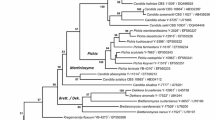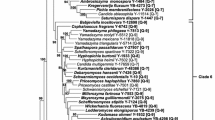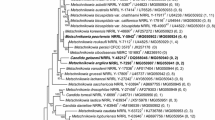Abstract
DNA sequence analyses have demonstrated that species of the polyphyletic anamorphic ascomycete genus Candida may be members of described teleomorphic genera, members of the Candida tropicalis clade upon which the genus Candida is circumscribed, or members of isolated clades that represent undescribed genera. From phylogenetic analysis of gene sequences from nuclear large subunit rRNA, mitochondrial small subunit rRNA and cytochrome oxidase II, Candida auringiensis (NRRL Y-17674T, CBS 6913T), Candida salmanticensis (NRRL Y-17090T, CBS 5121T), and Candida tartarivorans (NRRL Y-27291T, CBS 7955T) were shown to be members of an isolated clade and are proposed for reclassification in the genus Groenewaldozyma gen. nov. (MycoBank MB 815817). Neighbouring taxa include species of the Wickerhamiella clade and Candida blankii.

Similar content being viewed by others
References
Daniel HM, Lachance MA, Kurtzman CP (2014) On the reclassification of species assigned to Candida and other anamorphic ascomycetous yeast genera based on phylogenetic circumscription. Antonie van Leeuwenhoek 106:67–84
Dayo-Owoyemi I, Rosa CA, Rodrigues A, Pagnocca FC (2014) Wickerhamiella kiyanii f.a., sp. nov. and Wickerhamiella fructicola f.a., sp. nov., two yeasts isolated from native plants of atlantic rainforest in Brazil. Int J Syst Evol Microbiol 64:2152–2158
Dien BS, Kurtzman CP, Saha BC, Bothast RJ (1996) Screening of l-arabinose fermenting yeasts. Appl Biochem Biotechnol 57(58):233–242
Fonseca Á, Fell JW, Kurtzman CP, Spencer-Martins I (2000) Candida tartarivorans sp. nov., an anamorphic ascomycetous yeast with the capacity to degrade l(+)-and meso-tartaric acid. Int J Syst Evol Microbiol 50:389–394
Khunnamwong P, Surussawadee J, Jindamorakot S, Limtong S (2014) Wickerhamiella siamensis f.a., sp. nov., an endophytic and epiphytic yeast species isolated from sugar cane leaf. Int J Syst Evol Microbiol 64:3849–3855
Kurtzman CP (2015) Description of Martiniozyma gen. nov. and transfer of seven Candida species to Saturnispora as new combinations. Antonie van Leeuwenhoek 108:803–809
Kurtzman CP, Robnett CJ (1998) Identification and phylogeny of ascomycetous yeasts from analysis of nuclear large subunit (26S) ribosomal DNA partial sequences. Antonie van Leeuwenhoek 73:331–371
Kurtzman CP, Robnett CJ (2007) Multigene phylogenetic analysis of the Trichomonascus, Wickerhamiella and Zygoascus yeast clades, and the proposal of Sugiyamaella gen. nov. and fourteen new species combinations. FEMS Yeast Res 7:141–151
Kurtzman CP, Robnett CJ (2013) Relationships among genera of the Saccharomycotina (Ascomycota) from multigene phylogenetic analysis of type species. FEMS Yeast Res 13:23–33
Kurtzman CP, Robnett CJ (2014) Three new anascosporic genera of the Saccharomycotina: Danielozyma gen. nov., Deakozyma gen. nov. and Middelhovenomyces gen. nov. Antonie van Leeuwenhoek 105:933–942
Lachance MA, Kurtzman CP (2011) Wickerhamiella van der Walt. In: Kurtzman CP, Fell JW, Boekhout T (eds) The yeasts, a taxonomic study, 5th edn. Elsevier Science B.V., Amsterdam, pp 891–897
Lachance MA, Kurtzman CP (2013) The yeast genus Tortispora gen. nov., description of Tortispora ganteri sp. nov., Tortispora mauiana f.a., sp. nov., Tortispora agaves f.a., sp. nov., Tortispora sangerardii f.a., sp. nov., Tortispora cuajiniquilana f.a., sp. nov., Tortispora starmeri f.a., sp. nov., and Tortispora phaffii f.a., sp. nov., reassignment of Candida caseinolytica to Tortispora caseinolytica f.a., comb. nov., emendation of Botryozyma, and assignment of Botryozyma, Tortispora gen. nov., and Trigonopsis to the family Trigonopsidaceae fam. nov. Int J Syst Evol Microbiol 63:3104–3114
Lachance MA, Boekhout T, Scorzetti G, Fell JW, Kurtzman CP (2011) Candida Berkhout. In: Kurtzman CP, Fell JW, Boekhout T (eds) The yeasts, a taxonomic study, 5th edn. Elsevier Science B.V., Amsterdam, pp 987–1277
McNeill J, Barrie FR, Burdet HM, Demoulin V, Hawksworth DL, Marhold K, Nicolson DH, Prado J, Silva PC, Skog JE, Wiersema JH, Turland NJ (2006) International Code of Botanical Nomenclature (Vienna Code) Regnum Veg, 146. Gantner, Ruggell, Liechtenstein
McNeill J, Barrie FR, Buck WR, Demoulin V, Greuter W, Hawksworth DL, Herendeen PS, Knapp S, Marhold K et al (2012) International Code of Nomenclature for algae, fungi, and plants (Melbourne Code). Regnum Veg, 154. Koelz Scientific Books, Koenigstein
Ren YC, Wang Y, Chen L, Ke T, Hui FL (2014) Wickerhamiella allomyrinae f.a., sp. nov., a yeast species isolated from the gut of the rhinoceros beetle Allomyrina dichotoma. Int J Syst Evol Microbiol 64:3856–3861
Santa María J (1963) New melibiose-utilizing yeasts isolated from “alpechin”. Antonie van Leeuwenhoek 29:329–343
Santa María J (1978) Biotaxonomic studies on yeast. Commun Inst Nac Invest Agron, Serie General 3:1–61
Suzuki M, Suh SO, Sugita T, Nakase T (1999) A phylogenetic study on galactose-containing Candida species based on 18S ribosomal DNA sequences. J Gen Appl Microbiol 45:229–238
Tamura K, Peterson D, Peterson N, Stecher G, Nei M, Kumar S (2011) MEGA5: Molecular Evolutionary Genetics Analysis using maximum likelihood, evolutionary distance, and maximum parsimony methods. Mol Biol Evol 28:2731–2739
Acknowledgments
Mention of trade names or commercial products in this publication is solely for the purpose of providing specific information and does not imply recommendation or endorsement by the U.S. Department of Agriculture. USDA is an equal opportunity provider and employer.
Author information
Authors and Affiliations
Corresponding author
Rights and permissions
About this article
Cite this article
Kurtzman, C.P. Description of Groenewaldozyma gen. nov. for placement of Candida auringiensis, Candida salmanticensis and Candida tartarivorans . Antonie van Leeuwenhoek 109, 1041–1045 (2016). https://doi.org/10.1007/s10482-016-0703-8
Received:
Accepted:
Published:
Issue Date:
DOI: https://doi.org/10.1007/s10482-016-0703-8




